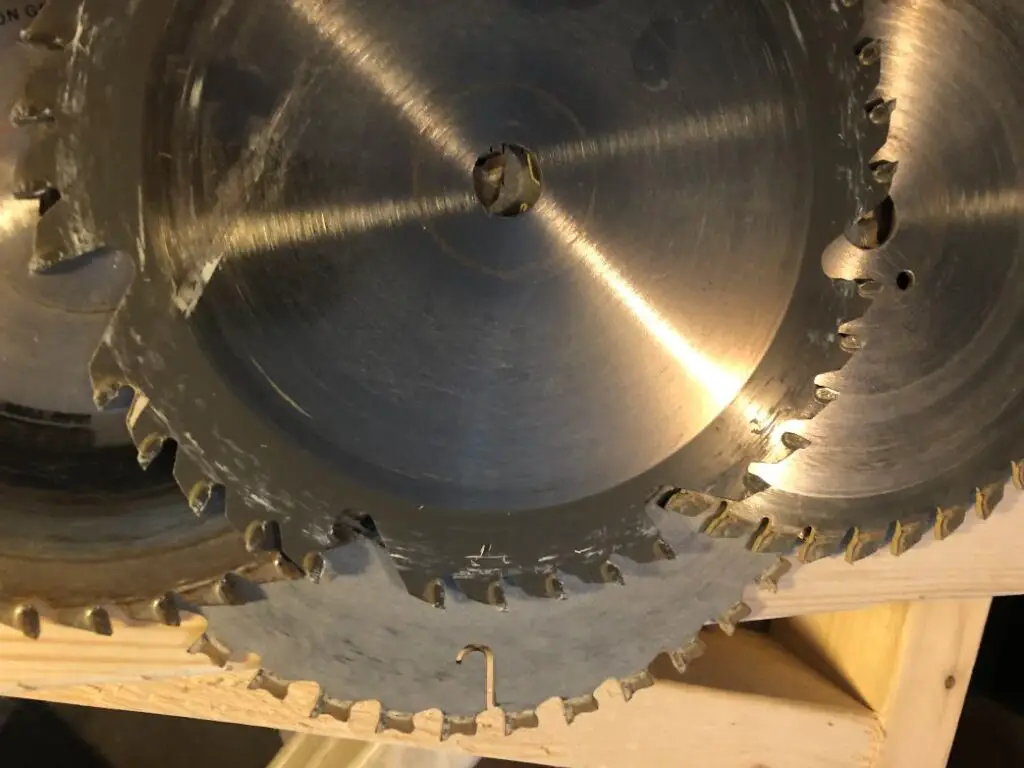A circular saw machine is among the most crucial woodworking tools needed in every workshop. Understanding how to properly sharpen a miter saw blade is a great thing to know!
After using this tool for a prolonged period, the blade becomes dull and blunt which can compromise the quality of the cuts you require. If this happens, your blade might require either sharpening of the teeth or cleaning.
Can You Sharpen A Miter Saw Blade?
Miter saw blades become dull due to frequent use. When the saw blade becomes dull, your saw becomes unable to cut with the accuracy and precision required.
Whenever this happens, it is advisable to sharpen the saw blade for quality performance. Additionally, sharpening increases the lifetime of your saw blade. However, it does not work the same as a new blade.
At times the saw blade becomes dull due to the build-up of sap and synthetic material which may diminish its cutting power.
In such an instance, sharpening the saw blade is unnecessary. The proper way of dealing with this is by cleaning the saw blade using an all-purpose cleaner and a plastic brush.
The dullness of the saw blade due to deposits is more common than the bluntness of the teeth. Therefore you might need to clean your blade about three times before you opt for sharpening.
How Do I Know If My Miter Saw Blade Is Dull?
Before deciding to sharpen your saw blade, you need to assess how dull the saw blade is. To do this, you will have to consider the following indicators.
- The blade begin splintering and chipping your work.
- When you see burn marks at the edge of the wood.
- The saw starts to stick in the cuts.
- When you notice chipped teeth on the blade.
- The blade wobbles and does not cut straight.
- Teeth appear rounded and smooth.
- When the saw motor becomes louder during cutting.
- More resistance when cutting.
Is Sharpening Circular Saw Blades Worth It?
Sharpening blades helps you cut the cost of buying a new saw blade. It also prevents the wastage of usable saw blades.
It is for this reason that the sharpening of blades is considered to be worth it. Additionally, blade sharpening costs way less as compared to replacement.
How Many Times Can You Sharpen A Saw Blade?
When a saw blade becomes dull and worn out, it’s time to sharpen it. However, there is a limit as to how many times you can sharpen a saw blade. After sharpening a saw blade 3 or 4 times, the saw begins to strain when cutting, although no burn marks appear.
This aspect shows that the blade has become weak and requires replacement. You can’t continue sharpening the saw blade at this point. The number of times a worn-out blade should be sharpened depends on the type of blade you are using.
How to Sharpen Your Miter Saw Blade By Hand
Sharpening a miter saw blade by hand is a viable option unless the blade’s teeth contain carbide material. In such circumstances, it is advisable to consider professional saw blade sharpening. Blade teeth made of carbide material are very hard in nature. These teeth are capable of damaging almost any file.
You will therefore need to consider seeking professional services to receive quality sharpening. Various service providers will sharpen your blade at a small fee. However, sharpening other types of blades yourself is possible and easy.
Here’s a videos to show you how easy it can be, don’t mind the “sharpening kit” he’s using. These kits are nice and make the job easier, but aren’t necessary.
Tools Required For Blade Sharpening By Hand
For the effective sharpening of the miter saw blade, you will require to collect the following tools.
- Crayon
- A small diamond file
- A workbench with mounting clamps
Below is the detailed procedure for sharpening a dull saw blade.
- Remove the blade The first step of sharpening a dull miter saw blade is removing it from the saw. The saw blade is removed because you cannot file it while still in the saw. Most miter saws have a blade release switch that helps you remove it conveniently. After removing the blade, place it on the workbench over the clamps.
- Put markings on the teeth It is a requirement that you put markings on the teeth of the saw blade using the Crayon before you start sharpening the saw blade. Marking the teeth reduces the risk of time wastage, which occurs when you file the same teeth twice and leave other teeth dull.
- Filling the tips of every tooth After prepping the blade for sharpening. You can start filing one tooth at a time to ensure that you sharpen all the teeth properly. To file, place the diamond guide at the front edge of the first tooth. Then make upward and forward slow movements along with the tips of the tooth. While filing, the face of your file should lean against the flat part of the blade. Through this process, be careful and avoid touching the point of the sharpened teeth.
- Repeat the third step for every tooth After sharpening the first tooth of the blade, repeat the process for each tooth. You will need to do this until you return to the first tooth you marked with the Crayon.
- Turn the blade over After you finish sharpening one side of the saw blade, you should then turn it over and file the other side. Repeat the third step for each tooth. Upon finishing this sharpening procedure, you can remove the saw blade from the clamps and return it to the saw machine.
How Much Does It Cost To Sharpen a Saw Blade?
Carbide-tipped blades are difficult to sharpen because of their hardness. Processionals, therefore, use power grinder equipment. This equipment contains a diamond wheel that grinds saw blades at specific angles for quality sharpening.
The cost for a professional sharpening is about 25 to 50 cents per tooth.
For example, Dynamic Saw located in Buffalo, New York, offers miter saw blade sharpening.
Their cost ranges from $9-$30 USD depending on how many teeth the blade has.
Sharp saw blades play a tremendous role in ensuring accuracy and cutting precision during woodworking.
You should, therefore, always work with sharp saw blades. In case these blades become dull and worn out, you should get them sharpened either by a professional or sharpen them yourself.
Giving your miter saw blades a quick sharpening with a file at home is great for the first few times.
After the third or fourth time you’ll want to send it off for a professional grade sharpening. This will help ensure you haven’t cause uneven wear from your own sharpening.

